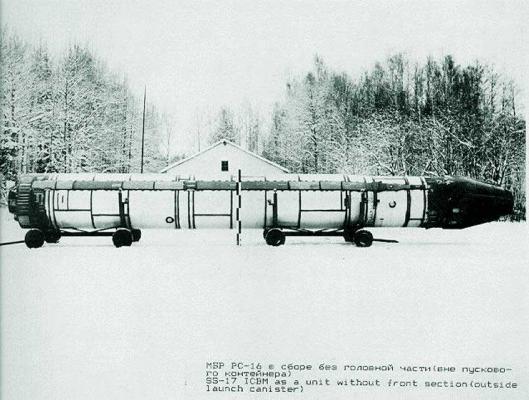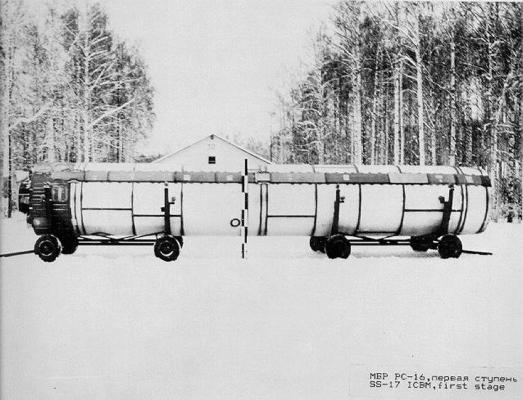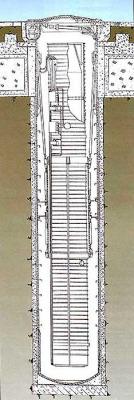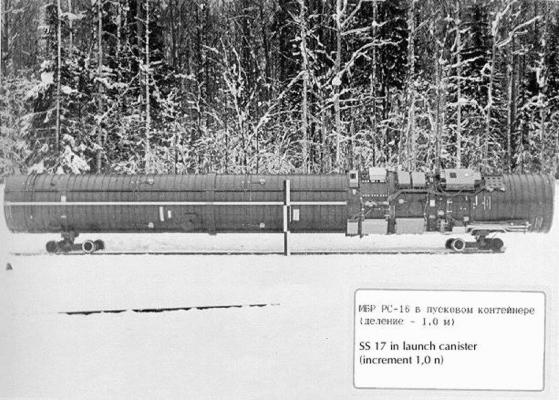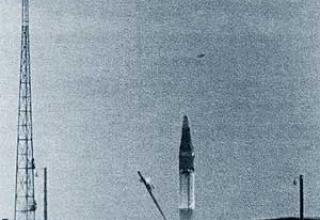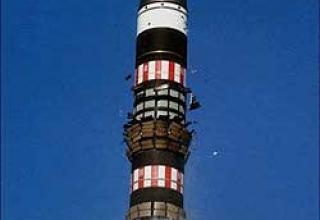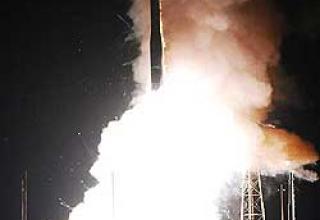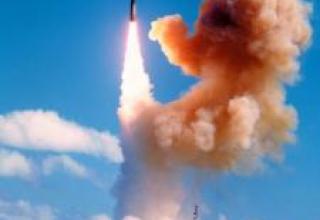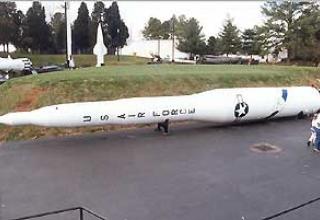Decree of the Government of the USSR N 682-218 of August 19, 1970 the parent organizations - Yuzhnoye Design Office and the Central Design Bureau - were tasked with developing projects for upgrading the strategic missile system UR-100, which is on combat duty. In accordance with this resolution, Yuzhnoye DO was entrusted with the development of a missile system with an intercontinental missile MR-UR100 (15A15) with access to flight and design tests in 1973. The task was to modernize the UR-100 complex with minimum time and costs. The UR-100 (8K84) lightweight missile was developed by the Central Design Bureau, adopted by the Strategic Missile Forces in 1967, was relatively inexpensive and was produced in mass quantities for the rapid build-up of the USSR military potential in competition with the USA. In total, about one thousand missiles were deployed. Due to the moral aging of the UR-100 missile it was necessary to install new, more modern and effective intercontinental missiles in the existing mine facilities. Development on a competitive basis stimulated rival organizations to improve the TTH complex and accelerate the pace of work.
The start of work on 15P015 complex in Yuzhnoye DO coincided with the works on creation of strategic missile complex "heavy" class R-36M (15P014) with 15A14 missile. The intensive development of these two new third-generation complexes was performed by the design team almost simultaneously. The complex with the MR-UR100 missile was created about a year later and this made it possible to borrow new, promising design solutions from the R-36M complex and thus reduce its development time. Both complexes used the schemes of mortar launch from the industrial complex, splitting head units (DHD), control systems based on BCVM, a single unified combat unit, similar to the design and layout schemes of solid fuel engines of DHD.
The high degree of continuity contributed to the accelerated rate of development of the 15A15 missile. Flight tests of 15A14 and 15A15 missiles started almost simultaneously.
The 15P015 (MR-UR100) missile system with the 15A15 missile equipped with a dividing head unit was adopted by the USSR Strategic Missile Forces in 1975. On May 6, 1975 in Bologoye the first missile regiment armed with this missile system was put on duty.
Since 1979, began replacing part of the 15A15 (MP-UR100) missiles, in deployed missile regiments, with a modernized version - 15A16 (MP-UR100UTTH). In the second half of the 1980s, it was decided to gradually withdraw this family of missiles from service. By the time the START-1 Treaty was signed, only 47 of them remained on combat duty, and in 1995 the last of them were eliminated.
In the west, the complex was designated SS-17 Mod.1,2 (under the START-1 Treaty - RS-16A).
Composition:
The two-stage MR-UR100 lightweight tandem ICBM (see the schematic) was designed with two diameters larger than those of the UR-100: the diameter of the first stage was 2.25m and the second stage 2.1m. The steps were connected to each other by a conical transition compartment, which was destroyed by an elongated cumulative charge (CCF) encircling the transition compartment in the middle when the steps were separated. This scheme was applied for the first time in Yuzhnoye SDO developments. On both stages fuel tanks and oxidizer tanks were combined into single fuel tanks, with intermediate bottoms made of tri-metal sheet (AMg6+AD1+AMg6) with secondary sealing of welds. For the production of fuel tank shells, stronger wafer shells were used, the production technology of which was first mastered in the case of the P-36M rocket.
The MR-UR100 missile used the so-called "chemical" pre-injection of fuel tanks, as well as fences of the original design with destratifiers ("stirrers"), which provided the minimum residue of fuel in the tanks. The fuel system of the rocket was completely ampulsified, eliminating the need for pneumatic testing at the sites of operation.
Braking of the second stage hull at the separation of the HC was carried out by the gas jet system by bleeding the inflation pressure from the cavities of the fuel compartment. The opening of the counter-retraction nozzles was carried out by the UKZ. The rocket was equipped with a new fuel management system (FMS) to ensure simultaneous emptying of fuel tanks and optimal use of fuel reserves, resulting in a significant increase in the rocket's energy.
The first stage was equipped with a single-chamber marching engine (developed by the Design Bureau for Electrical Engineering) of the second stage of R-36M rocket and a four-chamber control engine 15D167 developed by the Design Bureau for Electrical Engineering on the basis of 8D68 and 8D612 serial engines. The 15D167 ZHRD, made under the open scheme without afterburning, provided for the first stage, besides its main function, also the fuel tank pressurization with reducing gas, oxidizer and tank pressurization unit fuel supply and hydraulic drive system fuel supply, and for the second stage - fuel components supply of tank pressurization systems. The combustion chamber ZHRD 15D167 with a nozzle of tubular design was designed with a maximum degree of unification with the engine 8D612 brake control of 8K69 missile HCV. To accommodate the marching engine, the fuel tank of the first stage was made with a concave bottom.
Single-chamber marching ZHRD of the second stage 15D169 of the closed scheme was placed in a toroidal cavity of a fuel tank. The traction vector was controlled by blowing generator gas into the critical part of the nozzle. Four nozzles operated by TNA gas generator were used for roll control. The 15D169 ZHRD also ensured that the oxidizer tank of the second stage was inflated with the gas produced by the supercharged gas generator and the fuel tank with the reducing generator gas extracted after TNA. The engine was developed on the basis of 15D512 second stage LRD of 8K99 missile with some improvements to increase reliability and resource.
The solid propellant engine 15D171, developed by Yuzhnoye SDO and NPO Altai, was used for propulsion of SDO 15D161 and 15D221 of 15A14 missile, and the difference in the main characteristics (working fuel reserve, total thrust pulse, operating time) is due to a smaller number of SDO. Programming of the thrust was carried out due to the choice of solid end combustion fuel charge in the conical casing. Reducing the cross section of the burning surface of the charge in time provided a smooth reduction of the traction.
The autonomous, inertial control system was developed on the basis of DHM with automated measurement of command instrument errors and automatic introduction of corresponding corrections into the flight task in the minimum time after receiving the start command. The control system allows for re-targeting during prelaunch preparation. The control system is placed in a single sealed container that separates itself from the missile and provides for the flight of the RSH. This solution made it possible to abandon the instrument casings, bring them as close to each other as possible by reducing their weight and the weight of the cable network, provide better conditions for the operation of the equipment and significantly reduce the size and weight of the instrument compartment. Sealed instrument compartment became the object of dual use: first, as part of the rocket during the flight of the first stages, and then, after separation from the rocket, together with the RSH, provided its flight and breeding of BB.
The severe restrictions on the missile's length led to the need for another innovation - a special head fairing with a folding tip made of two half-shells was developed, which after the exit of the missile from the control room were folded under the influence of spring drives and formed a sharp cone.
As a result, the developed RPG for the MR-UR-100 missile is an unsurpassed example of mass perfection to this day.
Missiles combat equipment
- Splitting head end with 4 PFBBs resistant to 0.4 Mt each;
- monoblock HF with 3.4 Mt of PSE resistant BB.
Battle missile system (BRK) - stationary, with ground-safe automated mine launchers and command post (KP). Launch - mortar, from the TIC with the help of the PAD. Combat application is provided at any time of year and day, in any weather conditions, as well as after the impact of nuclear weapons (within the protection of MRK). Aziming the missile at the azimuth is provided by a fully autonomous system (without the use of ground geodetic network), the sighting system uses an automatic gyrocompass and a quantum optical gyrometer, placed in the PU. The sighting system provides primary detection of the azimuth of the base direction when the missile is placed on active duty and its storage in the course of active duty, including in the event of a nuclear impact on the launcher, and restoration of the azimuth of the base direction after the impact.
Composition of the DBK
- ten automated single launchers on the basis of existing "OS-84" PU;
- unified control unit of mine type of container version;
- unified system of combat control and internal power supply.
The distance between the neighboring PU, PU and PU of its DBK and the flank PU of the neighboring DBK is 6-8 km.
In the variant of "OS-84" PU upgrading proposed by the KBSM (Chief Designer - A.F. Utkin), the construction part of the BCP was preserved to the maximum extent possible and the main elements of a modified BCP (15P715) were to be industrially manufactured, i.e. a swing type protective device, a power metal cup, etc., while the protection of the structure was increased at least 15 times. An important feature of the 15P715 SHP was the fact that the shaft launch unit did not have power-consuming systems of temperature-moisture regime and provided the necessary microclimate due to continuous thermal insulation on the outer surface of the metal structure of the structure and the protective roof, as well as double rubber sealant on the roof perimeter. Inside the launcher with the rocket were only passive means of air drying - cassettes with sorbent (calcium chloride), which were replaced under the regulations.
The transport and launch container for the 15A15 missile was a 2x20m welded cylinder made of AMg6 aluminium alloy with a number of ribs on the outer diameter. The difficulty of manufacturing TIC of such large dimensions was the high accuracy of processing the inner cavity to ensure tightness at the exit of the missile. Originally, its production was supposed to be carried out at Omsk Aviation Plant N 166 (later NPO Polet), but later a new manufacturer of TPK was appointed - Zhdanovskiy plant Tyazhmash.
The general assembly of the rocket, loading into the industrial complex, complex check of rocket systems and ground checking and launching equipment installed at the industrial complex is carried out at the plant. Loading of the industrial complex with the rocket at all stages of operation - cranelessly in any weather conditions. The ground vehicle of high cross-country ability of the TIC with the missile is delivered to the PU without inspections at the technical position. Loading of the TPK with the rocket to the PU - by means of the unified hoisting and transport equipment. Filling the missile with fuel - by means of unified means of mobile refueling equipment without the presence of personnel in the PU. Fueling of the missile with the fully assembled and tested MS - with the help of unified for all types of combat equipment of transport and installation equipment.
Characteristics:
| General characteristics | |
| Target range of fire, km: - maximum with VHF - maximum with monoblock HF - minimum |
10250 10320 1000 |
| Firing accuracy (range 10000 km), km | ±1.6 |
| Breeding area BB, km | 200х100 |
| Stand by, s. | 80 |
| Warranty period of being on combat duty under the regulations once in 3 years, years | 10 |
| 15A15 missile | |
| Launching weight of the rocket, tc | 71.2 |
| Weight of the head end, kgs | 2100 |
| Flight Reliability | 0.957 |
| Diameter, m | 2.25 |
| Length, m | 22.51 |
| Remote Control Features | |
| Traction remote control (on the ground / in the void), ps: - Stage I main engine - Stage I steering - II stages |
117 / 126 28 / 33 - / 14.5 |
| a specific remote control pulse in the void, s: - Stage I - II stages |
318.5 330.5 |
Testing:
Flight and structural tests of the MR-UR-100 missile began at NIIP-5 under the leadership of the State Commission, headed by Colonel-General F.P.Tonkikh and his deputy, Chief Designer of the DEC V.F.Utkin. Beginning of the LKI - 1972, ending - 1975.
Total number of launches during the LKI - 40, of them:
- in the Kura district - 32
- in the area "Water area" - 7
- at the minimum range (in the "Kzyl Tu" district) -1
- number of emergency stops - 3
- the number of partially successful launches is -2.
The total number of launches was 67, of which 7 were emergency launches. Successful launches - 89.5%.
Sources:
- "Призваны временем. Ракеты и космические аппараты конструкторского бюро "Южное"./ Под общей редакцией С.Н.Конюхова/. Д.: Арт-Пресс, 2004,-232с.
- "КБ специального машиностроения: От артиллерийских систем до стартовых комплексов" (под редакцией Ушакова В.С.) .СПб, 2004.
- Карпенко А.В., Уткин А.Ф., Попов А.Д. "Отечественные стратегические ракетные комплексы". СПб, Невский бастион-Гангут 1999 год.
- UR-100MR / SS-17 SPANKER
